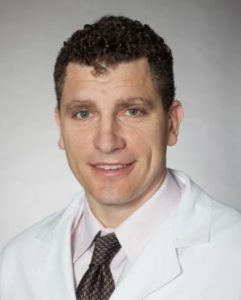Home to the only Level I trauma center in southern New Jersey, Cooper University Hospital has a team of orthopaedic surgeons with an unparalleled depth of expertise in correcting the effects of trauma, deformities, and other musculoskeletal problems.
While these board-certified, fellowship-trained orthopaedic traumatologists provide immediate, around-the-clock attention to patients of all ages who have experienced severe traumatic injuries—what’s called “hot” trauma—they also are equipped to handle complex cases in which an original injury hasn’t healed correctly,
even months after the initial trauma.

Kenneth W. Graf, MD
Director, Orthopaedic
Trauma Program and
Fracture Care
“These are classified as ‘cold’ trauma cases,” explains Kenneth W. Graf, MD, director of Cooper’s Orthopaedic Trauma Program and Fracture Care, “and can include bones that haven’t healed, or have healed mal-aligned or short, or complex injuries that require the bone to be re-broken and realigned.
“One of the most common cold trauma issues we see on referral is a U-type pelvic fracture,” he notes. “Radiographs reveal only about 30 percent of sacral fractures, so they’re missed by a lot of ERs that can’t figure out why patients aren’t able to walk.”
Some of the other complex cases Dr. Graf and his colleagues, Henry J. Dolch, DO, and Rakesh P. Mashru, MD, see are acetabular fractures (a break in the socket portion of the ball-and-socket hip joint) and periarticular fractures that occur around or immediately adjacent to a joint.
“We often have to delay surgery for these complicated breaks that go into the joint while the soft-tissue swelling subsides,” Dr. Graf notes.
Cooper’s Reconstructive Orthopaedic Trauma Surgery team has pioneered minimally invasive fracture surgery and limb-lengthening techniques here in South Jersey, contributing to their consistent track record of successful outcomes even in the most complex cases. They are particularly adept at an advanced form of limb-lengthening known as bone transport, a salvage technique in which bony tissue is regenerated to fill a gap where bone is missing due to trauma or infection.

Henry J. Dolch, DO, and patient.
“We recently had to remove a 13-centimeter diseased portion of a patient’s femur/ tibia,” Dr. Graf explains. “Then, using an external fixation device, we’re lengthening the healthy portion of the bone a little bit each day so the leg can be used again.”
Helping patients to regain function is one of the most gratifying aspects of the work Dr. Graf and his team performs.
“We see a fair number of patients who aren’t functioning as well as we’d expect with the types of breaks they have had,” he notes. “And, unfortunately, many are told that that’s the best they’ll be able to do.
“Usually, that’s not true,” he adds. “We have many different options to get people back to functioning more fully. The earlier [after a break] we can see someone, the better chance they have of doing well. But even if it’s months later, we’re equipped to help improve patients’ function.”
Notably, Cooper has earned global recognition for its capabilities in treating geriatric hip fractures. In fact, Cooper is the only hospital in the state certified by the International Geriatric Fracture Society (IGFS), an acknowledgment to its full continuum of care which ranges from osteoporosis intervention to extensive rehabilitation services.
“We do a lot of complex procedures here,” Dr. Graf says, “but we also take care of the basics, like hip or wrist fractures, extremely well.” ■
